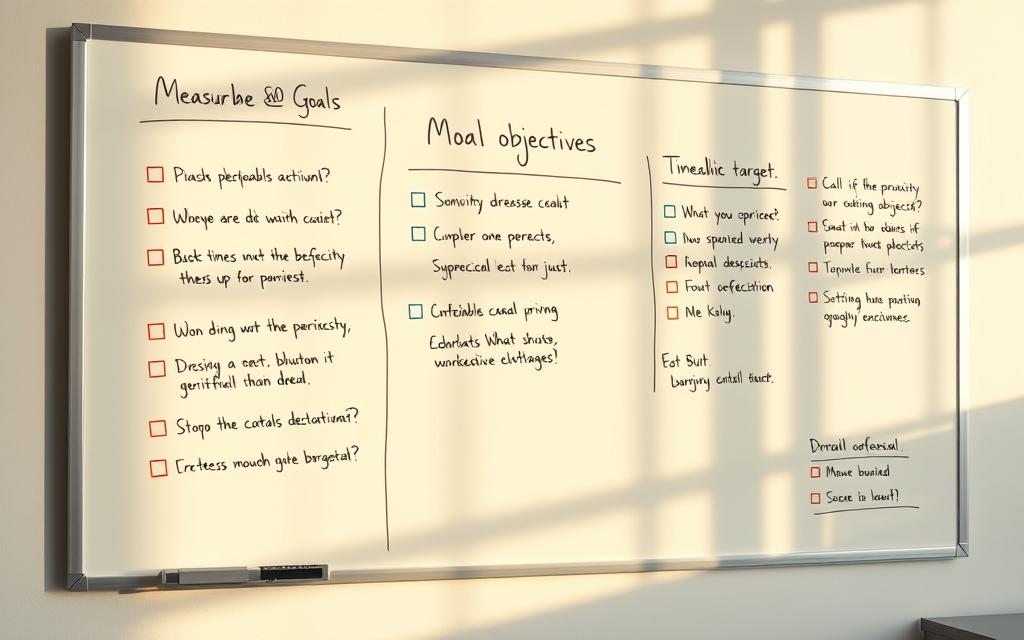What if you could turn your biggest dreams into reality? Setting clear objectives is the first step toward creating meaningful change in your life. Whether you want to improve your fitness, advance your career, or save for a big purchase, defining what matters most helps align your actions with your values.
Many people start strong but lose momentum quickly. Why? Often, they skip the foundational work of breaking big aspirations into smaller, achievable steps. For example, someone aiming to save $5,000 this year might begin by putting aside $20 weekly. These micro-actions build confidence and create lasting habits.
This article shares practical strategies used by successful individuals across fields. You’ll learn how visualization, accountability systems, and the SMART framework turn vague ideas into actionable roadmaps. By focusing on progress over perfection, you’ll discover how even modest efforts compound into extraordinary results over time.
Ready to take charge of your growth? Let’s explore how intentional design can transform your ambitions from “maybe someday” to “I’m doing this.”
: Understanding the Importance of Goal Setting
Why do some people consistently move forward while others stall? The answer often lies in how they structure their ambitions. Clear objectives act like a compass, turning abstract ideas into actionable steps that drive daily decisions.
What Objectives Are and Why They Matter
Think of objectives as your personal roadmap. They define what success looks like and create a sense of direction. For instance, a marathon trainee might aim to run three times weekly. This specificity helps track progress and adjust efforts when needed.

Benefits of Clear, Measurable Targets
When targets are specific, you gain three advantages:
- See tangible progress through small wins
- Stay motivated by recognizing incremental improvements
- Identify what works quickly to refine strategies
Research shows people who measure their advancement are 42% more likely to stay committed. This approach transforms vague wishes into achievable milestones. For example, saving $100 monthly feels manageable compared to a distant $5,000 target.
By breaking down aspirations, you create a system where every action has purpose. This clarity not only boosts confidence but also turns overwhelming challenges into conquerable tasks.
: Essential Goal Planning Tips
Ever wonder why some plans stick while others fizzle out? The secret lies in designing your year with intentional steps that match your daily rhythm. Start by identifying one area where small changes could create big impacts – like reorganizing your morning routine or dedicating 15 minutes daily to skill-building.

Practical Advice for Setting Attainable Goals
Break large ambitions into bite-sized actions. A student aiming for straight A’s might start with three focused study sessions weekly. Similarly, someone improving their health could begin with 10-minute walks after meals. These micro-steps build momentum without overwhelming you.
Try this approach:
- Write down two specific targets for the next 90 days
- Schedule time blocks in your calendar for focused work
- Track progress weekly using simple checklists
People who integrate goals into their existing routines are 63% more likely to maintain them long-term. For instance, pairing bill payments with monthly savings transfers creates automatic financial growth. Remember, success comes from consistent small steps – not overnight transformations.
By aligning your efforts with natural daily patterns, you create systems that support lasting change. This method turns abstract dreams into concrete results, helping you craft a more balanced and fulfilling life.
: Getting Started: Visualizing Success and Starting Small
Imagine standing at the finish line before the race begins—how would that change your approach? Visualization lets you mentally rehearse outcomes, making ambitious targets feel attainable. Studies show this visualization technique boosts motivation by 20% compared to vague aspirations.

Techniques for Effective Visualization
Create a personal vision statement describing your desired future in vivid detail. Athletes often use mental imagery to “practice” perfect performances. Similarly, writing down three sensory-rich details about your success—like the sound of applause or the warmth of pride—sharpens focus.
Building Confidence with Small Wins
Start with tasks requiring minimal effort but delivering quick results. Writing 100 words daily or walking 10 minutes after lunch establishes momentum. Track these micro-achievements in a notebook or app. Each checkmark reinforces your capability to follow through.
This process works because small steps reduce overwhelm. Spending time upfront to design a clear roadmap helps you sidestep distractions later. Over weeks, these consistent actions become automatic—transforming effort into habit.
: Implementing the SMART Method for Goal Planning
Ever felt stuck between big dreams and daily routines? The SMART framework bridges that gap by turning “someday” ideas into structured action plans. This method helps you craft objectives with built-in accountability, making progress easier to track and celebrate.

Breaking Down Specific, Measurable, Achievable, Relevant, Timely Goals
Each letter in SMART represents a critical checkpoint:
- Specific: Define exact outcomes (“Complete Python course”)
- Measurable: Track progress with numbers or milestones
- Achievable: Match ambitions to available resources
- Relevant: Align targets with broader priorities
- Timely: Set clear deadlines to maintain focus
Real-Life Examples Using SMART Goals
A student might set this academic target: “Raise math grade from B to A by semester’s end through 45-minute daily practice.” For career growth, a marketing professional could aim: “Master Google Analytics certification in 8 weeks by dedicating 3 hours weekly.”
These examples show how SMART criteria create actionable roadmaps. By defining the end result and practice schedule, you’ll find clearer ways to advance without burnout. Regular check-ins let you adjust efforts while staying on course.
: Recruiting a Support System and Building Accountability
What separates those who achieve their aspirations from those who don’t? Often, it’s the people surrounding them. A well-structured support network acts like scaffolding—providing stability during challenges and amplifying victories through shared celebration.
Identifying an Accountability Partner
Choose someone who understands your priorities and offers honest feedback. Fitness enthusiasts might partner with a gym buddy to track weekly workouts, while professionals could team up with mentors to review career milestones. Effective partners do three things:
- Schedule regular check-ins (biweekly calls or shared progress apps)
- Celebrate progress without ignoring areas needing improvement
- Adapt support styles to match your learning preferences
College success centers showcase this perfectly—students using peer tutors improve grades 34% faster than those working alone. Whether improving health habits or mastering new skills, accountability turns vague intentions into concrete actions.
Leveraging Community and Team Support
Groups create momentum through collective energy. Workplace teams that set quarterly targets together achieve 28% higher success rates. Online forums for writers or runners foster camaraderie, while local clubs turn solitary efforts into social experiences.
Here’s how to maximize group dynamics:
- Join communities aligned with your objectives (professional networks, hobby groups)
- Share weekly updates to maintain visibility and encouragement
- Rotate leadership roles to keep engagement high
When challenges arise, a robust team provides diverse perspectives to help you pivot strategies. This collaborative approach transforms individual efforts into shared victories.
: Developing a Flexible and Adaptive Goal-Setting Process
Life rarely follows a straight path—why should your strategies? Staying rigid when circumstances shift often leads to frustration. The key to lasting progress lies in creating systems that bend without breaking.

Adjusting Your Targets Based on Feedback
Regular check-ins help spot what’s working and what needs tweaking. A runner training for a marathon might reduce mileage after noticing joint pain, swapping long runs for swimming sessions. This adaptive approach protects their outcome while preventing injury.
Try these three strategies to stay nimble:
- Review progress biweekly using measurable data
- Ask mentors or peers for objective perspectives
- Test small changes before overhauling entire plans
A student balancing coursework could adjust study hours based on exam results. Shifting from six-hour weekend marathons to 90-minute daily sessions often yields better retention. These actions demonstrate how minor pivots maintain momentum.
Feedback plays a critical role in this process. Internal reflections (like journaling) highlight personal growth areas, while external input reveals blind spots. Combining both creates a complete picture of where adjustments matter most.
Remember: Flexibility isn’t failure—it’s smart adaptation. By refining your training methods or daily routines, you align efforts with evolving realities. This mindset turns unexpected challenges into stepping stones toward your desired outcome.
: Aligning Your Environment: Systems Over Goals
Your surroundings shape your success more than you might realize. Like a ship’s rudder guiding its course, daily systems determine whether you drift or move purposefully toward results. While goals set direction, it’s your environment that fuels consistent action—especially during challenging days or multi-month projects.

Optimizing Your Workspace for Better Focus
Start by designing spaces that reduce friction. Students preparing for exams might clear desk clutter to create mental clarity, while remote workers could position monitors at eye level to minimize strain. Three adjustments boost productivity:
- Use task-specific zones (dedicated areas for studies, creative work, or admin tasks)
- Organize digital files with clear naming conventions
- Block distracting websites during deep work sessions
Research shows organized environments cut task completion time by 18%. For example, labeling supplies or bookmarking frequent tools saves minutes daily—time that adds up over months.
Managing Distractions and Creating Positive Defaults
Replace willpower with smart design. Place healthy snacks at eye level instead of chips. Set phone notifications to “focus mode” during work hours. These default settings make good choices automatic.
Strengthen your relationships with time and space by:
- Scheduling email checks twice daily
- Using noise-canceling headphones in open offices
- Creating evening rituals to prep for tomorrow’s priorities
When your environment supports your aims, progress becomes inevitable. A writer might leave their manuscript open overnight—making it easier to resume work each morning. Small tweaks like these turn aspirations into daily habits.
: Tracking Your Progress and Celebrating Small Successes
Progress isn’t just about reaching the finish line—it’s about knowing you’re headed in the right direction. Regular check-ins act like mile markers on a highway, showing how far you’ve come and what adjustments might be needed. Whether you’re working toward personal growth or professional milestones, tracking creates clarity and momentum.
Effective Methods for Monitoring Milestones
Tools matter. A simple notebook for daily wins or apps like Habitica turn abstract efforts into visible streaks. Try these approaches:
- Color-coded calendars highlighting completed actions
- Spreadsheets tracking skill development hours
- Weekly voice memos reviewing challenges and wins
Feedback from your community adds perspective. Share updates with a mentor or peer group—they’ll spot patterns you might miss. One study found people who discuss progress monthly are 57% more likely to achieve goals than those working in isolation.
Reward Strategies to Maintain Motivation
Celebrations fuel persistence. Link rewards to specific checkpoints:
- After 30 consistent workout days: New athletic gear
- Completing a certification: Weekend getaway
- Weekly writing targets: Favorite coffee treat
These long-term goals become more attainable when paired with immediate joys. Research shows micro-rewards boost commitment by 38%. For bigger achievements, consider experiences that reinforce your growth—like attending a workshop mentioned in this self-improvement guide.
Remember: Recognition matters even for small steps. A high-five from your workout buddy or a quiet moment of pride creates positive reinforcement loops. Over time, these moments build the resilience needed for life’s bigger climbs.
: Conclusion
Transforming aspirations into achievements isn’t magic—it’s strategy. By pairing smart goals with daily systems, you create a roadmap where every action counts. Visualization sharpens focus, while the SMART framework turns vague ideas into measurable steps you can track and refine.
Support networks and adaptable strategies keep momentum alive when challenges arise. Align your environment to reduce friction—whether organizing workspaces or setting automatic reminders. Regular check-ins let you track progress and celebrate small wins, building confidence through visible growth.
Remember: Success thrives on iteration, not perfection. Adjust timelines if needed, but keep making progress. Start today by defining one specific goal and breaking it into this week’s actionable steps. Every choice nudges you closer to the life you envision.
Ready to unlock your potential? Grab a notebook, outline your first milestone, and begin. With these tools, you’ll turn “someday” into “done” faster than you think.
